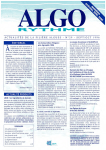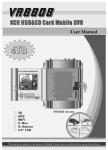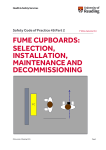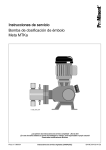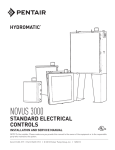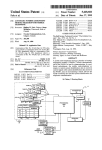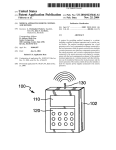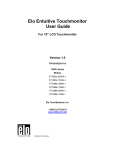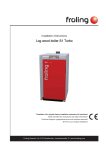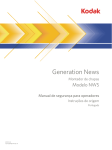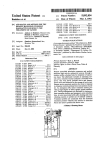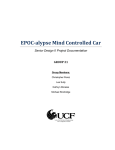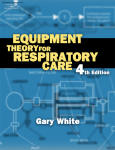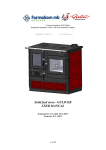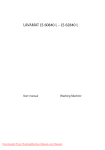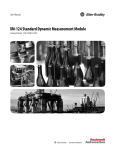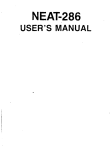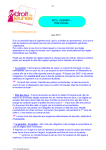Download Method and apparatus for encapsulating particulates
Transcript
US005878355A United States Patent [19] [11] Patent Number: Berg et al. [45] [54] [75] METHOD AND APPARATUS FOR Date of Patent: 4318885 6/1994 Germany ' Inventors: Robert O. Berg, Paso Robles, Calif; 463169 2/1992 Japan ' William F. Rigby; John P. Albers, OTHER PUBLICATIONS bth fR'hl dW h. 0 1C an ’ Mar. 2, 1999 FOREIGN PATENT DOCUMENTS ENCAPSULATING PARTICULATES 0 5,878,355 as Webster’s [73] Assignee: Encapsulation Technology, LLC, Los II NeW Riverside University Dictionary (Excerpts) no date Angeles, Calif Primary Examiner—Kathryn Gorgos Assistant Examiner—Edna Wong [21] App IN . 0.: 706217 , [22] Filed: A ttorney, A gent, Aug. 30, 1996 [57] Related US Application Data 0r F'trm—Ch" r1st1e, Pk ar er &Hl a e, LLP ABSTRACT An improved method and device for decontamination of a contaminated process area is provided Whereby a ?ne aero [60] Provisional application No, 60/003,106 Sep, 1, 1995' [51] Int. Cl. 6 [52] [58] _ sol of an encapsulant for use in encapsulating the contami _ nants Within the contaminated environment is generated. ............................ .. G221?‘ 9/00,'A62D 3/00, The aerosol is generated by a plurality of ultrasonic trans_ B0 D 7/00’ B01J 13/02 US. Cl. ............................... .. 588/2; 588/16; 588/237; 427/212; 427/2133 Field of Search .................................. .. 588/2, 16, 18, ducers located beloW the surface of a reservoir containing a Capture liquid' The Output of the transducers is focused to a point near the surface of the liquid to cause a surface disturbance WhiCh results in the formation of an aerosol of 588/237; 427/212> 2133 encapsulant from the capture liquid. Apressurization fan is used to force ambient air through the pressurization chamber [56] References Cited to transport the aerosol to the process area to be treated. The US PATENT DOCUMENTS aerosol forms a thin coating of encapsulant over the'haz ardous material thereby allowing the hazardous material to 2,070,578 2/1937 Bowman ............................... .. 261/121 2,663,382 12/1953 Dautrebande be Safely removed from the process area or permanently 183/121 adhered to the Walls of the process area. If a chemically 2,807,504 9/1957 BloXsom .............................. .. 299/885 hazardous material is found in the process area, a Capture 3:892:543 7/1975 15513121]? 3,901,443 3,911,684 4,526,808 1 liquid can be selected to neutralize the hazardous material. _______ _ _ _ _ _ _ __ 55/96 8/1975 Mitsui et a1. . 10/1975 Busey . ... ... ... . 239/102 . . . . .. The process is especially effective at recovering radioactive dust from a Contaminated Process area 60/644 7/1985 Strohmaier .............................. .. 427/57 1O 12 Margraf \ AEROSOL l4\ 33 Claims, 3 Drawing Sheets 16 \ PROCESS jg CHAMBER U.S. Patent Mar. 2, 1999 Sheet 2 of3 5,878,355 FIG.2 19% f0 92 2 84 > > U.S. Patent Mar. 2, 1999 Sheet 3 0f 3 5,878,355 mm /\ 55\iéw/bi:é V)9 \\ A f3Kwpbh:m /\ \f r w: / 5,878,355 1 2 It is important to recogniZe that an aerosol is de?ned as a METHOD AND APPARATUS FOR ENCAPSULATING PARTICULATES suspension of tiny droplets of liquid. In many Ways, an aerosol can be made to behave like a gas. For example, it can be made to How from areas of high concentration to areas of loW concentration. It can also be used to ?ll an enclosed This application claims the bene?t of US. Provisional Application No. 60/003,106 ?led Sep. 1, 1995. space like a gas. Nonetheless, the individual droplets that form the aerosol retain the chemical properties of a liquid. Therefore, the individual droplets that form an aerosol are FIELD OF THE INVENTION This invention relates to a method and apparatus for the encapsulation of hazardous materials found as particulates so as to prevent the particulates from becoming airborne. More particularly, it relates to the generation of an aerosol for use in the decontamination of an enclosed space by using technically already condensed as tiny droplets of liquid. 10 HoWever, the use of the term “condense” herein is generally meant to refer to the agglomeration of enough aerosol droplets to form large droplets that can no longer behave in the gas-like fashion of a true aerosol. 15 ticles can be either left in place or safely removed so as to ventilation ducts, process glove boXes, “in?nity” rooms, air locks, process piping, process vessel internals, destruction eliminate the risk of resuspension of the contaminants. Work areas and large area hot cells. It can also be useful for the aerosol to encapsulate contaminants such as haZardous dust found in the enclosed space. By encapsulating the contaminants With a capture coating, the encapsulated par Process areas Where this invention could prove useful are long-term mothballing of industrial or manufacturing facili BACKGROUND OF THE INVENTION The decontamination of certain contaminated environ ments has proven to be especially problematic. In particular, Where contamination levels or physical con?guration of the environment make conventional access impractical, removal of those dust particles can be dif?cult. For eXample, in nuclear laboratories and the nuclear poWer and nuclear ties. Chemically reactive aerosols can also be useful in 20 neutraliZing process areas such as fume hoods or areas of chemical spills. By encapsulating haZardous material With the device and method of the present invention, the possibility of an air borne haZard to humans can be reduced or even eliminated. 25 Consequently, the device and method can make it possible Weapons manufacturing industries, the generation of radio for humans to Work on or Work in contaminated areas Which active dust has led to severe contamination problems. Often entire rooms or systems of ventilation equipment including ducts contaminated With radioactive dust have had to be Were previously inaccessible due to the airborne haZard. sealed because no practical method of decontamination Was The device is especially useful for decontamination of 30 process areas contaminated With haZardous particulate mat ter such as plutonium contamination or other radioactive dust. A polymeric coating material or capture liquid can be formed into an aerosol by the device and method of the knoWn. In some instances, entire buildings have been sealed and condemned in place because contamination prevents the destruction of the building. Once an environment has been sealed, the particles tend to fall out of the atmosphere and deposit on the surfaces of the ?oors and Walls of the closed present invention. The aerosol can then be introduced into the process area such as through eXisting ventilation ducts to create a fog Which passively ?lls the enclosed space Without environment. HoWever, the slightest disturbance of the generating signi?cant turbulence. The capture liquid is atmosphere of the closed environment can result in resus selected so as to form a layer of encapsulant over the pension of the particulates Which Will tend to ?oat freely Within the atmosphere. Conventional contamination control methods have been unable to effectively control such con taminants. Such a result is often unacceptable, especially if the particulates contain a highly haZardous radioactive mate rial such as plutonium. Attempts to decontaminate, maintain, and even enter many of these types of areas have resulted in the resuspen eXposed surfaces of the process area, thereby encapsulating 40 the haZardous dust. Once the dust is so encapsulated, it can be further treated in various Ways. For example, it can be collected along With the encapsulant for proper disposal. As an alternative, a second layer of more durable material can be applied over the ?rst layer before removal. The initial 45 capture liquid may also be selected so as to form a perma nent coating over the haZardous material so that it can be sion of the contaminants. This resuspension can lead to an permanently encapsulated in place. airborne haZard for humans, resulting in an uptake of the haZardous material. capture liquid. Submerged beloW the surface of the liquid SUMMARY OF THE INVENTION The device includes a primary reservoir for containing the 50 Within the reservoir are one or more pieZoelectric transduc ers for generating ultrasonic Waves focused to a point near the surface of the liquid. Preferably siX transducers are used in parallel. The focused ultrasonic Waves created by the According to the present invention, a device and method for encapsulating haZardous particulates found Within a transducers cause a disturbance at the liquid surface Which, process area are disclosed. The particulates are encapsulated by forming an aerosol of a capture liquid Which is introduced to the process area. The aerosol encapsulates the particulates 55 and adheres them to the surfaces of the process area. The individual droplets that form the aerosol are of a de?ned siZe distribution and can be produced Without signi?cant turbu lence. The device does not use heat to form the aerosol and, 60 therefore, avoids any undesirable separation or thermal breakdoWn of the chemical constituents that are to be formed into the aerosol. The aerosol generated is passive in nature making it effective in process areas Where turbulence is to be avoided. The device can be used With a broad range of liquids Without the undesirable effects of other aerosol generators. 65 in turn, causes tiny droplets of the liquid to shear off and form the aerosol. The liquid level of the primary reservoir is maintained by an over?oW Weir. By maintaining the liquid level constant, the transducers are kept in focus as the liquid is driven off. The liquid spills over the over?oW Weir into an over?oW reservoir located beloW the primary reservoir. A recircula tion pump is used to transfer the over?oWing liquid back from the over?oW reservoir to the primary reservoir and thereby maintain the liquid level constant. The reservoirs are enclosed Within a pressuriZation cham ber With inlet and outlet ports. Afan at the inlet port supplies ambient air into the pressuriZation chamber in order to create 5,878,355 3 4 a slight positive pressure in the pressurization chamber. This air is used to carry the aerosol from the pressurization chamber through the outlet port Where the aerosol can be best understood With reference to the folloWing detailed directed into the process area Which is to be encapsulated. One advantage of such a device is that the equipment used can be placed outside the process area to minimize distur apparatus for decontamination of a process area; FIG. 2 is a partly schematic elevation vieW of an aerosol description of the invention and draWings in Which: FIG. 1 is a block ?oW diagram illustrating the method and bances Within the process area. Once the process area has been ?lled With a fog of the generator according to the present invention; encapsulating aerosol, a steady state condition can be main tained by WithdraWing an exhaust stream portion of the in generating the ultrasonic signals used in the present inventions; and atmosphere from the process area for treatment in a recovery FIG. 3 is a block diagram illustrating the electronics used 10 FIG. 4 is a partly schematic elevation vieW of a recovery chamber While continuing to direct aerosol into the process chamber according to the present invention. area. An exhaust fan draWs the exhaust stream from the process area into the recovery chamber. A spray of liquid such as distilled Water is used in the recovery chamber for condensing the aerosol. The liquid spray system also 15 The process and device of the present invention includes tWo key components: an aerosol generator and an aerosol includes a sump for collecting the spray and a recycle pump so that the spray can be reused. The exhaust stream then passes through a moisture separator for further removal of moisture from the exhaust stream. From the moisture separator, the exhaust stream is directed through a high recovery chamber. As illustrated in the block ?oW diagram of FIG. 1, the aerosol generator 10 is used to produce an aerosol of a capture liquid such as a polymeric encapsulant Which is carried by ambient air 12. An aerosol stream 13 is ef?ciency particulate air ?lter for providing the ?nal process ?ltration step to the exhaust stream. A fully ?ltered exhaust generated and used to ?ll an enclosed environment such as a process area 14 in order to capture any hazardous dust that may be present in the process area. Once the process area has stream can then be released into the atmosphere or directed to further treatment facilities. By measuring the amount of aerosol removed from the 25 process area and calculating the amount of aerosol added to the process area, the total amount of aerosol deposited on the surfaces of the process area can be estimated. Once the desired amount of aerosol has been deposited on the surfaces, the aerosol generator can be shut doWn and the recovery system used to recover the remaining airborne aerosol from the process area. Upon contact With the surfaces of the process area, the aerosol forms a thin ?lm Which encapsulates the hazardous material. Preferably the aerosol is formed from a capture liquid that coalesces upon contact With the surfaces so as to been suitably ?lled With aerosol, a portion of the aerosol can optionally be purged by removing an exhaust aerosol stream 15 from the process area for recovery of the aerosol in an aerosol recovery chamber 16 While continuing to add aero sol to the process area. The aerosol recovery chamber is used to capture the aerosol and any other airborne contaminants before the exhaust air 18 is released into the atmosphere. A Technical Manual and an Operations and User Manual for a commercial embodiment of the invention are attached as Appendix A and Appendix B, respectively, and are herein 35 form a tacky or sticky coating over the hazardous material. incorporated by reference. The use of such equipment is especially useful for decon tamination of a hazardous dust-laden atmosphere. For example, in the nuclear poWer, and the nuclear Weapons While it is preferred that the aerosol be introduced passively into the process area, that is, With little or no turbulence, by using a tacky capture liquid, even if some of the particulates are disturbed and resuspended, they Will either tend to settle onto the tacky surfaces of the thin ?lm for encapsulation, or Will become encapsulated While airborne and then settle manufacturing industries and in nuclear laboratories, pro cess areas have been knoWn to become contaminated With radioactive dust. By creating an aerosol of a capture liquid, the dust can be encapsulated Within a ?lm of a coating material Which is formed on the exposed surfaces of the onto the tacky surfaces of the process area. Once the aerosol treatment has been completed, various clean up methods can be employed. For example, Workers Wearing the appropriate protective gear can enter the enclosed environment and either collect the encapsulated hazardous material from the surfaces of the enclosed envi DETAILED DESCRIPTION OF THE INVENTION 45 process area. Once the hazardous dust has been so encap sulated by the ?lm, the hazardous material can be removed from the surfaces along With the coating material and disposed of properly. This method is also useful for collection of other hazard ronment or perhaps apply a second, more durable coat of encapsulant. In some instances, the process area can be ous dusts including lead dust, asbestos dust and beryllium dust. Moreover, it can be useful for the neutralization of chemical hazards Which may be present in the form of airborne droplets, vapor or particulates as Well as chemical hazards that exist as surface contamination. entered Without the need for respiration or other protective equipment as the process virtually eliminates the hazard of inhalation exposure. So as to avoid human entry into the process area, robots may also be used to scrape or otherWise Many different liquids can be used for the capture liquid. 55 remove the hazardous material from the surfaces. For radioactive dust, the liquid should be selected to aid in In some process areas, such as those contaminated With managing the dust, and perhaps to alloW personnel to enter asbestos dust, a more permanent coating can be applied Which need not be removed. Either the initial capture liquid the contaminated area. HoWever, it generally cannot be used to neutralize the hazard. A tacky capture liquid such as a can be selected to form a permanent coat, or a second coat Water-based urethane suspended in a tWo-part organic solu tion Works Well. The encapsulant formed by such a capture liquid stays someWhat tacky, even after it has coalesced on can be applied With the aerosol generator to permanently encapsulate the contaminants. In such instances, the coating of the exposed surfaces effectively eliminates the hazard the surfaces of the process area. This alloWs any residual or Without the need for removal or further treatment. BRIEF DESCRIPTION OF THE DRAWINGS airborne contaminates to adhere to the layer of encapsulant. 65 When treating a process area contaminated With radioac The process and device for decontamination of process tive dust, it is also preferred that the capture liquid be areas contaminated With hazardous particulates or dust are selected so as to avoid creation of a mixed Waste. If a 5,878,355 5 6 chemically hazardous material is used for the capture liquid, removed from the process area. While solvent based solu tions Will often Work Well, Water based solutions are gen erally preferred so as to avoid the possibility of creating an the encapsulated radioactive dust Would be classi?ed as a mixed Waste as it Would be both chemically and radioac tively haZardous. The disposal of mixed Waste is very explosive atmosphere Within the process area. Since the process area to be treated generally includes air, suitable capture liquids include those that Will oxidiZe in air to dif?cult as most haZardous Waste facilities are designed for the handling of only one, but not both types of Waste. Depending on the amount and type of radioactive material to be encapsulated, criticality concerns can arise by the encapsulation of the radioactive material. Moreover, the addition of an encapsulant containing hydrogen can increase criticality concerns as hydrogen is knoWn to increase the encapsulate the particulates. The aerosol is formed by an aerosol generator as illus trated in FIG. 2. The aerosol generator includes a cabinet 19 10 reactivity of nuclear material by moderating or reducing the energy level of the neutrons emitted. By proper selection of the type and amount of the capture liquid, such criticality containing a pressuriZation chamber 22 in Which the aerosol is produced. Preferably the pressuriZation chamber is a stainless steel tank. By providing a stainless steel pressur iZation chamber that is generally resistant to chemical attack, many different chemical materials can be used With a single concerns can be mitigated. Moreover, by adding a suitable neutron poison such as boron, a neutral, or even a negative 15 generator for forming the aerosol. reactivity coef?cient can be achieved for a particular capture Within the pressuriZation chamber are tWo internal liquid reservoirs, a primary reservoir 24 and an over?oW reservoir 26. The capture liquid 28 to be formed into an aerosol is placed in the over?oW reservoir. The use of a ?ll tube Will liquid. For many haZardous dusts such as asbestos dust or lead dust, the encapsulation of the particulates can often render them harmless. For treating a process area contaminated With these particulates, an encapsulant that hardens into a simplify the addition of liquid. The liquid in the over?oW durable, permanent layer may be preferred. In the tube 34 for a capture liquid recirculation pump 36. The recirculation pump circulates the liquid through a recircu lation tube 38 up to the primary reservoir. The total liquid reservoir ?oWs into a sump 32 Where it is draWn to a suction alternative, a tacky encapsulant may ?rst be used to capture all the particulates including the airborne particulates. Then, a more permanent and harder outer coating can be applied capacity of the combined reservoirs is about three gallons over the tacky coating. Either the aerosol generator or conventional spray techniques can be used to provide this With about one gallon in the primary reservoir and about tWo outer coating. sulating haZardous particulates might be particularly useful The suction and recirculation tubes are preferably pro vided as a single, continuous, ?exible tube. The recirculation pump is preferably a peristaltic pump that recirculates the is in the treatment of ventilation ducts contaminated With liquid Within the tubing by acting on the external Walls of the asbestos ?bers. By permanently encapsulating the ?bers tubing. Such pumps are Well knoWn in the medical device against the Walls of the ducts so as to prevent them from becoming airborne, the risk of asbestos exposure can be mitigated While alloWing the continued use of the ducts. A motors that alloW the recirculation rate to be varied betWeen gallons in the over?oW reservoir. One example Where such a method of permanently encap industry. Such pumps are poWered by variable speed d.c. 35 periodic treatment of the ducts With added layers of coating about 1 and 20 ml per minute. Aperistaltic pump is preferred as it does not come in direct contact With the liquid. This material at established intervals Will ensure that the ?bers makes cleaning the aerosol generator easier and eliminates are prevented from breaking loose. the possibility that the capture liquid may be incompatible Such a permanent encapsulation method can also be With the pump or that leakage of lubricants from the pump useful in permanently mothballing a process area containing could contaminate the capture liquid. In the preferred embodiment, the tubing is also disposable to further simplify radioactive or other haZardous dust. Periodic recoating can also be useful Where the contaminated particulates are cleaning. The use of an inexpensive, disposable pump is also susceptible to atomic recoil. If a process area is contaminated by chemically reactive contemplated so as to avoid the expense of a peristaltic pump. 45 BetWeen the primary and over?oW reservoir is an over vapors or particulates, the aerosol generator can be used With an appropriate neutraliZing agent and/or buffers to chemi ?oW Weir 42 Which maintains the capture liquid level 44 in cally neutraliZe the haZard. Such a procedure can be useful in process piping Where the piping is unable to Withstand the hydrostatic pressure that Would be realiZed if a method of liquid treatment Were undertaken. As just one example, an the primary reservoir at a constant level. Once the level of the capture liquid in the primary reservoir reaches the height of the over?oW Weir, excess liquid spills over the Weir and into the over?oW reservoir. acidic process system can be effectively neutraliZed through Under the surface of the capture liquid in the primary the generation of a caustic aerosol. It can also be useful in some instances to add a pigment or dye to the capture liquid. By adding color to the capture liquid, a simple visual inspection of the surfaces of the process area can be used to con?rm that an even layer of encapsulant has been applied. It should also be recogniZed that very simple chemical compositions can be quite effective at encapsulating haZ 55 reservoir are a plurality of pieZoelectric ultrasonic transduc ers 46. Preferably six transducers are placed Within the reservoir at the vertices of a normal hexagon. The six transducers are arranged to point upWard toWards the surface of the liquid in the primary reservoir. The depth of each transducer is adjusted to focus its output to a point near the surface of the liquid. Each transducer is of a cup shape that ardous dust. For example, a balanced mixture of monosac helps to focus the output signal to a point. Each of the six transducers is preferably fastened to a mounting plate 48 by charides and polysaccharides dissolved in deioniZed Water can be produced into an aerosol for effectively capturing a stainless steel mounting tube 52 so that all of the trans ducers can be moved up or doWn Within the primary reservoir as a unit. haZardous dust. The inherent stickiness of such a solution adds to its effectiveness. 65 In the preferred embodiment, transducers made from a lead Zirconate titanate material knoWn as PZT-4 are used. As pointed out, many different materials can be used for forming the aerosol depending upon the type of haZard to be This material yields high poWer drive transmission charac 5,878,355 7 8 teristics Which are ideally suited to high driving ?elds. The having different sound velocities, such as the liquid-air interface in the primary reservoir, a shear Wave is generated. transducers are approximately one inch in diameter and focus at approximately one inch in demineraliZed Water. The precise focus can vary based on a number of factors Which Will be addressed in further detail later. The transducers are The transducers are focused so that the shear Wave is mounted to the stainless steel mounting tubes by a conduc tive O-ring Which provides the ground contact. Nickel electrodes are used for the poWer supply. Such preferred transducers have a resonance frequency of about 2300 kilohertZ. In order to avoid interference betWeen the signals of the six transducers, they should be separated from one another by about 2 to 21/2 inches. By mounting the six 10 capture liquid before generating the aerosol. The heating element is located beloW the over?oW reservoir. A thermo couple is located in the primary reservoir and a temperature transducers on the apexes of a normal hexagon With 21/2 inch sides, interference effects are negligible. The mounting plate is located beloW the primary reser voir. Each of the six mounting tubes extends through an ori?ce 54 at the bottom of the primary reservoir. The ori?ces 15 include seals so that the height of the transducers can be adjusted up or doWn by sliding the mounting tubes up or doWn through the bottom of the primary reservoir Without the capture liquid leaking. The ef?ciency of the transducers is improved by having the inside of the mounting tubes exposed to air rather than liquid as this causes the transduc ers to focus their output toWard the denser capture liquid rather than back through the air of the mounting tubes. Atransducer level adjusting assembly 58 is used to adjust the height of the mounting plate to thereby adjust the level of the transducers Within the primary reservoir. The adjust approximately at the liquid level of the primary reservoir so as to shear off a portion of the liquid and form tiny droplets of the liquid as an aerosol. While the tiny droplets act similar to a gas in their ?oW properties, they maintain the physical properties of a liquid. Referring back to FIG. 2, it is preferred that the over?oW reservoir include a heating element 72 for heating the 25 controller is provided to alloW the temperature of the capture liquid to be set. By adjusting the temperature of the capture liquid, the properties of the aerosol to be generated can be varied. For example, if the liquid is maintained at a tem perature 10 to 15 degrees Fahrenheit higher than the tem perature of the process area, the resulting aerosol Will tend to ?ll the process area from the top doWnWard. Conversely, if the liquid is maintained at a temperature 10 to 15 degrees Fahrenheit loWer than the temperature of the process area, the process area Will tend to ?ll from the bottom upWard. Depending on the ventilation and air ?oW paths of the particular process area, such ?exibility can be useful. The aerosol droplets formed by the transducers are trans ported from the pressuriZation chamber by the use of pres suriZed air. A pressuriZation fan 76 located at a pressuriZa ing assembly preferably includes three threaded drive heads, mounting plate can be raised or loWered as necessary to tion chamber inlet builds the pressure Within the pressuriZation chamber such that the aerosol can be carried by the air into a collection funnel 78, through a discharge chimney 82 and out a pressuriZation chamber outlet 84. The simultaneously change the position of all of the transducers pressuriZation fan is preferably a variable speed d.c. poW three threaded drive posts, and a belt that turns the three drive heads simultaneously. A drive knob With a drive pulley is used to turn the belt. By turning the belt, the transducer relative to the surface of the liquid in the primary reservoir. The electronic equipment used for driving the transducers is best illustrated in FIG. 3. A variable frequency oscillator 62 is used to generate a high frequency sine Wave 64. A preferred oscillator is a digital function generator/counter 35 pressuriZation chamber should be high enough to cause How of aerosol into the process area Without stirring up the haZardous dust contained in the process area. The aerosol stream from the pressuriZation chamber outlet port is capable of producing sine, square, triangle, pulse and ramp directed to the process area by the use of a ?exible conduit Wave forms. The unit has an adjustable frequency range from 0.1 hertZ to 2.3 megahertZ in seven ranges. It has a variable output amplitude from 5 mv to 20 Vp-p, variable symmetry/duty cycle from 5% to 95% in the ramp or pulse mode, continuous or externally controlled outputs. A d.c. ered fan With an adjustable ?oW rate of betWeen 2 and 20 cubic feet per minute. The pressure maintained in the connected to an existing ventilation system. The aerosol generator cabinet also includes four adjust able feet 86 for leveling the primary reservoir. Each foot is 45 offset betWeen —10 v to +10 v can be added to any of the output Wave forms. attached to a threaded stud With a knurled head. Each stud mates With the threads of a threaded aperture on the cabinet frame such that the feet can be individually adjusted by turning the knurled heads. A bubble level can also be The Wave generated by the oscillator is ampli?ed by a continuous Wave poWer ampli?er 66. The preferred ampli provided on the transducer mounting plate to assist in levelling the cabinet. It is important that the reservoirs be ?er is a solid state ampli?er With a ?at frequency response from 100 kilohertZ to 5 megahertZ. It provides 50 Watts of linear poWer With loW harmonic and intermodulation dis perfectly level so that the transducers are properly focused. The cabinet includes a control panel 92 Which alloWs the tortion. The ampli?ed signal 68 from the ampli?er is split and used to drive the six transducers. When the transducers are vibrated at their resonance 55 frequency, they are positively displaced. The movement of adjustment of the oscillator frequency, the poWer ampli?er output, the temperature of the capture liquid and the speeds of the pressuriZation fan and recirculation pump. Displays for transducer output, oscillator frequency, reservoir temperature, recirculation pump rate, poWer ampli?er each transducer creates a high frequency sound Wave. Because the transducers are cup-shaped, the output of each is focussed to a point. The useful range of frequencies in generating an aerosol are from 0.025 to 2.3 megahertZ. While the choice of transducer Will determine the resonance frequency at Which the oscillator Will be set, a variable output, and pressuriZation fan ?oW rate are also included. The control panel is preferably cooled With a 45 cubic foot per minute a.c. poWered cooling fan. In order to simplify clean up, the cabinet for the aerosol frequency oscillator is useful for alloWing ?ne tuning of the rear and loWer front panels also provide easy access to the generator includes a pair of hinged side doors. Removable aerosol generator, as Well as the substitution of different transducers in different applications. When the longitudinal sound Waves generated by the transducers impinge a boundary betWeen tWo materials pressuriZation chamber. The pressuriZation chamber is 65 mounted in the cabinet on a track Which alloWs it to be slid out for maintenance and cleaning. A pair of threaded studs lock the pressuriZation chamber in position along the track 5,878,355 10 during operation. The pressurization chamber also includes decreases as temperature rises. Therefore, in addition to a removable top section to further simplify cleaning. In order to clean the pressurization chamber, the cabinet is opened, then the primary and over?oW reservoirs are drained of any excess liquid through drain openings. The pressuriZation chamber is unlocked and slid out along the track and the top is removed. The surfaces of the funnel and using the capture liquid heater to vary the temperature of the aerosol generated, it can be used to vary the surface tension and thereby vary the aerosol generator ef?ciency. chimney are Wiped With a cloth and the reservoirs are rinsed With a suitable cleaning solution depending on the capture liquid used. The surfaces of the reservoirs and pressuriZation chamber are then Wiped With a clean cloth. The tubing for the liquid recirculation can be either cleaned or discarded. Because the aerosol is generated by ultrasonic Waves rather than by mechanical noZZles or other conventional methods for generating an aerosol, there is very little tur 10 15 Other factors can also affect the How rates required for the aerosol stream. An increase in the temperature of the process area Will result in loWer ?oW requirements. Conversely, increases in the humidity of the process area can require increased ?oW rates. The properties of the materials to be coated Within the process area can also impact the How rates. A higher coefficient of friction alloWs increased ?oW rates. Furthermore, if the process area is a great distance from the aerosol generator or at a higher elevation than the aerosol generator, higher ?oW rates may be required. Finally, if multiple coats of encapsulant are to be applied, higher ?oW rates may be required. While the focus point for the transducers is generally at bulence generated. Therefore, the resulting aerosol can be used to gently ?ll the process area Without resuspending a signi?cant portion of the contaminants. Most of the con the capture liquid level of the primary reservoir, the precise taminants remain on the surfaces of the process area Where level to Which the transducers should be submerged in the capture liquid can vary. The precise depth to Which the they can be encapsulated by the capture liquid. The aerosol droplets encapsulate the particulates by colliding With the surfaces of the process area to form a thin ?lm. Only a small transducers should be adjusted is determined by the chem istry and temperature of the capture liquid, and the poWer amount, if any, if the haZardous material is caused to become resuspended by the aerosol stream. In order to further 2 mils can have an impact on the ef?ciency of the aerosol prevent the particulates from becoming resuspended, loW and frequency applied to the transducers. Variations of 1 to 25 aerosol stream rates are desired. Preferred ?oW rates are generator. Fine tuning of the precise depth of the transducers can be achieved by adjusting the depth While visually checking the characteristics of the aerosol generated. The betWeen 2 and 20 cubic feet per minute. By maintaining loW ?oW rates, streaking or puddling of the encapsulant on the depth should be adjusted so that a dense fog of aerosol is surfaces of the process area is avoided. produced. The need for ?ne tuning of the transducer depth One important advantage of the aerosol generator of the present invention is that by properly selecting the transduc ers and the capture liquid, and by properly controlling the may also be due to the effects that the transducers have on various operating parameters, an aerosol of a fairly uniform droplet siZe can be produced. Moreover, the siZe of the aerosol droplets can also be controlled. 35 the surface of the capture liquid When operating. For the transducers described above, a cone-shaped node approxi mately 1A1 inch in height forms above each transducer. The aerosol is produced from the tips and sides of the nodes. An optional aerosol recovery system of the present inven In general, small aerosol droplets are preferred. The tion is illustrated in FIG. 4. In using such a recovery system, droplets should be small enough to behave like a gas in that they ?oW from areas of high concentration to areas of loW an exhaust aerosol stream is WithdraWn from the process area through a ?exible duct. The exhaust stream then enters concentration Without condensing. The siZe of the droplets the loWer portion of a recovery chamber 101. The recovery chamber includes a plurality of spray noZZles 102 Which are can be controlled by selection of the transducer and capture liquid. Generally, the higher the resonance frequency of a used to expose the exhaust to a spray bath. The spray transducer, the smaller the aerosol droplet. For the preferred generated by the noZZles is used to form a spray to both saturate the exhaust and cause the droplets to increase in transducer described above as having a resonance frequency of about 2300 kilohertZ, 95% of the aerosol droplets Will be 45 in the range of 0.3 to 5 microns for distilled Water With a mean droplet diameter of about 2 microns. For the capture siZe. As the droplets increase in siZe, they start to condense and fall to the bottom of the recovery chamber. Preferably distilled Water is used for the spray though solvent based solutions may also be used so as to be compatible With the liquid, higher frequency is required to produce aerosol droplets of a smaller mean droplet siZe. If larger aerosol droplets are produced, higher aerosol stream ?oW rates are capture liquid selected. generally required. recovery chamber and ?oWs to a suction tube 106 of a The condensed liquid collects in a sump 104 in the peristaltic spray recirculating pump 108. The spray recircu lating pump discharge is recycled through a recycle tube to the spray noZZles to produce additional spray. The preferred In general, loW aerosol stream ?oW rates are desired so as to minimiZe turbulence in the process area. HoWever, the physical properties of the particular capture liquid used can affect the How rate. The viscosity and surface tension are the properties that can most affect the How rate. Changes in these properties can also have an impact on the poWer 55 Preferably the initial volume of spray liquid is measured so that the increase in volume and, therefore, the amount of aerosol recovered can be calculated. The difference betWeen the increase in the volume of liquid in the recovery system and the decrease in volume in the aerosol generator alloWs requirements, and hence, the ef?ciency of the process. For highly viscous capture liquids, the ef?ciency decreases and higher ?oW rates are required. As surface tension of the capture liquid increases, the ef?ciency of the aerosol gen eration increases. HoWever, the ef?ciency curve generally includes a critical point after Which further increases in surface tension can decrease the ef?ciency of aerosol gen eration. The temperature of the capture liquid can also affect the How rate and ef?ciency due to its affects on the surface tension of a capture liquid. Surface tension generally ?oW rate is about one gallon per minute, although this can be varied depending on the aerosol to be recovered. for a mass balance calculation in Which the total amount of capture liquid can be calculated. The preferred recovery chamber includes a cabinet With a 65 hinged top and removable side and back panels for access. A disposable glove bag liner With a capacity of about 16 cubic feet is used to line the cabinet. The glove ports 114 in 5,878,355 11 12 the liner are useful for adjusting the nozzles. Preferably, the atmosphere, the risk of explosion can be reduced. If nitrogen nozzles and recycle tubing are also disposable to simplify or some other gas is used as the carrier gas, it can be clean up. Because the peristaltic pump does not contact the spray, it need not be cleaned. HoWever, as With the recircu lation pump of the aerosol generator, an inexpensive dis provided in pressurized cylinders and the pressurization fan can be replaced by a pressure regulator. The process and apparatus Will be described further by the posable spray recirculation pump is contemplated to elimi folloWing examples. nate the cost associated With a peristaltic pump. After the exhaust stream ?oWs through the spray nozzles of the recovery chamber for aerosol removal, it proceeds to a moisture separator 116 Where most of the entrained liquid Will be removed. The preferred moisture separator is a EXAMPLE 1 10 A test booth Was constructed measuring eight feet long by four feet deep by eight feet high for a total volume of 256 disposable, lightWeight stainless steel mesh ?lter. cubic feet. Various test coupons Were placed Within the booth. The test coupons included samples of stainless steel From the moisture separator, the ?oW proceeds to a high-ef?ciency particulate air ?lter 118 in Which approxi mately 99.7% of particulate 0.3 microns in diameter and larger are removed. Preferably, the ?lter is disposable. Disposable materials are preferred for the recovery sys tem since some of the hazardous material from the process area may be carried from the process area by the aerosol. 15 painted dryWall, Wood and Wire insulation. Certain of the test coupons Were covered With a conventional strippable coating. The booth, including the test coupons, Was then dusted With a ?ne, highly mobile dust of ?uorescent poWder 20 Such hazardous material Will generally be at least partially encapsulated by the aerosol and Will be collected by the spray bath, the moisture separator or the ?lter. An exhaust fan 122 is used to maintain the recovery chamber at a slight negative pressure and to assist in draWing exhaust through the recovery system. Preferably a variable speed d.c. fan is used so that the ?oW rate of gas through the recovery system can be adjusted. The preferred range for the exhaust fan is betWeen about 4 and 25 cubic feet per minute. from about 1 to about 100 microns in diameter With a mean 25 30 the recovery system so as to maintain the desired ?oW of aerosol through the system. Apreferred pressure differential 35 0.5 inches of Water or less. In order to maintain ?oW through the system in the correct direction, the exhaust fan is generally run at a slightly higher ?oW rate than the pressur ization fan. The booth Was closed and the discharge of an aerosol generator of the present invention Was connected to an opening on the loWer third of the test booth door. A total of 1000 milliliters of capture coating Was introduced to the test booth as an aerosol through a four-inch ?ltered airWay. The ?oW rate of the aerosol Was controlled to a rate of less than ten cubic feet per minute through an injection nozzle With a nominal diameter of six inches. The total discharge time Was approximately four hours. During the test, the temperature and humidity of the test booth Were measured and compared to the ambient atmo sphere. The initial temperature of 76° F. and humidity of 40 for monitoring and controlling the spray ?oW and the exhaust ?oW. The liquid level in the sump can be visually inspected to calculate the volume of aerosol recovered. The nozzle spray pattern can also be visually inspected and adjusted manually through the glove ports. particle diameter of about 40 microns. A contamination survey using standard disc smears quanti?ed that 60 to 80% of the smear surface Was covered With the poWder. the pressure differential betWeen the aerosol generator and The aerosol recovery system also includes a control panel to simulate contamination of a process area With hazardous particulates. The individual dust particles ranged in size A differential pressure indicator can also be used to monitor betWeen the aerosol generator and recovery system is about plate, carbon steel piping, carbon steel valves, glass, plastic, 40% for the test booth matched the measurements for the ambient atmosphere. The temperature and humidity of the ambient atmosphere did not change during the test. While the temperature of the test booth did not change during the 45 test, the humidity increased to over 99%. The capture coating used for generating the aerosol Was a In practice, the aerosol generator is ?rst started so as to ?ll the process area With a fog of aerosol. An aerosol rate of sugar mixture comprising 2 parts by Weight polysaccharide, 18 parts by Weight monosaccharide and 80 parts by Weight about 1 liter per hour is generally adequate. Once the process deionized Water. area has been ?lled With this fog and an optimum concen 50 About one hour after stopping the generation of aerosol, tration of aerosol in the process area has been reached, the the test booth Was entered for visual inspection. Inspection aerosol recovery system is then started to alloW the simul taneous feeding and purging of the process area. By main taining a ?oW of aerosol through the system, the surfaces of the process area Will be evenly coated With the encapsulant. 55 While ?exible ducts are generally described for connect ing the aerosol generator and aerosol recovery system to the process area, hard ducts may also be used and are preferred in systems that Will operate for prolonged periods. Moreover, various other modi?cations to the presently described invention Would be apparent to one skilled in the art and are intended to be included Within the scope of this invention. For example, While air is generally described for 60 With a black light revealed the ?uorescent gloW of the simulated contamination under and Within the capture coat Which had deposited on all interior surfaces of the test booth including the test coupons. A survey using standard disc smears indicated that insigni?cant levels of ?uorescent poWder remained airborne in the test booth. The surfaces of the test booth and the test coupons Were fairly evenly covered With a thin, viscous layer of capture coating about 3 mils thick. Additionally, gentle rubbing of the coated surfaces While observing the ?uorescent poWder under a black light revealed that the ?uorescent poWder Was captured or “stuck” use as the carrier gas for carrying the aerosol into the process area; other gases may also be used. An inert gas such as 65 in place. Subsequent testing of the test coupons up to a year after the application of the capture coating revealed that the nitrogen may be useful as a carrier gas, especially if a ?uorescent poWder Was still-captured or “stuck.” ?ammable capture liquid is used. By maintaining an inert 5,878,355 14 13 10. The method of claim 1 Wherein the particulates are EXAMPLE 2 chemically reactive, the method further comprising the step of selecting the capture liquid from liquids that Will neu traliZe the particulates. 11. The method of claim 1 Wherein the capture liquid is A capture liquid useful for many different hazardous materials can be produced as follows: WEIGHT MATERIAL provided in a reservoir Within a pressuriZation chamber and PART A the step for introducing the fog to the process area comprises the step of pressuriZing the pressuriZation chamber to induce 3.95 1-methyl-2-pyrrolidinone 0.71 0.06 triethyl amine ammonium hydroxide 2.71 dipropylene glycol methyl ether 1.35 texanol ester alcohol 0.02 0.23 silicone glycol isopropyl alcohol 0.69 butyl benzyl phthalate 0.08 ammonium benzoate 8.78 16.20 polyurethane dispersion acrylic copolymer 40.22 Water 75.00 TOTAL PART B 5.00 0.13 How of the fog into the process area. 10 13. The method of claim 1 further comprising the step of coating the surfaces of the process area With a resinous material after the particulates have been encapsulated and 15 20 HDI based polyisocyanate 25.00 TOTAL adhered to the surfaces of the process area. 14. A method for collecting particulates from a process area containing surfaces exposed to the particulates, the method comprising the steps of: providing a reservoir of capture liquid; subjecting the capture liquid to ultrasonic Waves to gen erate an aerosol; and introducing the aerosol into the process area to coat the surfaces of the process area and encapsulate and adhere aliphatic polyisocyanate hexamethylene diisocyanate (HDI) 19.87 12. The method of claim 1 further comprising the step of heating the capture liquid. 25 the particulates against the surfaces With the aerosol. 15. The method of claim 14 Wherein the capture liquid has a liquid interface and the ultrasonic Waves are focused to a The polyurethane dispersion and acrylic copolymer used in this example Were products manufactured by Imperial Chemicals Limited and sold under the names NeoreZ R-9679 and Neocryl A-5045, respectively. 30 Part A and Part B are combined in the Weight ratio of 3:1 to form a capture liquid. Upon collision With the haZardous dust and the surfaces of the process area to be treated, the are selected to form an aerosol of droplets having a mean aerosol formed by this capture liquid begins to coalesce to form a tacky layer that can encapsulate the haZardous dust. What is claimed is: 1. Amethod for collecting particulates from a process area containing surfaces exposed to the particulates, the method comprising the steps of: generating a fog from a capture liquid; and 35 40 3. The method of claim 2 further comprising the step of ering the portion of the aerosol vented from the exhaust stream comprises the step of passing the exhaust stream the process area. 4. The method of claim 1 further comprising the step of selecting the capture liquid from liquids that Will harden to through a spray bath. 21. The method of claim 20 further comprising the step of passing the exhaust stream through a ?lter. 22. A method for removing haZardous particles from a the surfaces of the process area. 5. The method of claim 4 further comprising the step of scraping the encapsulated particulates from the surfaces of space enclosed by Walls, the method comprising the steps of: the process area. 55 supplying to a reservoir a liquid that can be bound to the particles and to the Walls; Wiping the encapsulated particulates from the surfaces of the subjecting the liquid to ultrasonic Waves to form an process area. atomiZed liquid; and 7. The method of claim 1 Wherein the process area 60 the process area by oxidation. process area. 19. The method of claim 18 further comprising the step of recovering a portion of the aerosol from the exhaust stream. 20. The method of claim 19 Wherein the step for recov removing the encapsulated particulates from the surfaces of 8. The method of claim 1 further comprising the step of selecting a non-haZardous capture liquid. 9. The method of claim 1 further comprising the step of selecting the capture liquid from liquids that Will form a hard, durable layer of encapsulant on the surfaces of the the particulates against the surfaces With the aerosol; an exhaust stream. 45 tacky layer on the surfaces of the process area. contains air, and further comprising the step of selecting the capture liquid from liquids that Will harden to the surfaces of generating an aerosol from a capture liquid; introducing the aerosol into the process area to coat the surfaces of the process area and encapsulate and adhere and venting a portion of the aerosol from the process area as the particulates against the surfaces With the fog. 6. The method of claim 1 further comprising the step of diameter of about 2 microns. 18. A method for collecting particulates from a process area containing surfaces exposed to the particulates, the method comprising the steps of: introducing the fog into the process area to coat the surfaces of the process area and encapsulate and adhere 2. The method of claim 1 further comprising the step of selecting the capture liquid from liquids that Will form a point near the interface. 16. The method of claim 14 Wherein the ultrasonic Waves are provided in a frequency range of betWeen about 1 kilohertZ to about 2.3 megahertZ. 17. The method of claim 14 Wherein the ultrasonic Waves introducing the atomiZed liquid into the space to encap sulate the particles and cause the encapsulated particles to adhere to the Walls. 23. The method of claim 22, in Which the liquid supplied comprises a liquid that hardens after exposure to the space. 65 24. The method of claim 23, additionally comprising the step of scraping the hardened liquid from the Walls after it adheres thereto to remove the encapsulated particles With the hardened liquid. 5,878,355 15 16 30. The method of claim 22, additionally comprising the step of heating the liquid in the reservoir. 31. The method of claim 22, additionally comprising the step of miXing Water vapor With the atomiZed liquid to control its humidity. 32. The method of claim 22, additionally comprising the 25. The method of claim 22, in Which the space is occupied by air and the liquid supplied comprises a liquid that hardens by oxidation after exposure to the air in the space. 26. The method of claim 22, in Which the liquid comprises a liquid that is nonhaZardous. 27. The method of claim 22, in Which the atomiZing step comprises subjecting the liquid in the reservoir to ultrasonic step of coating the Walls With a resinous material after the Waves in the frequency range of 1 KHZ to 2.3 MHZ. 28. The method of claim 22, in Which the atomiZing step comprises subjecting the liquid in the reservoir to ultrasonic Waves having characteristics that atomiZe the liquid into 10 under a surface of the liquid such that the ultrasonic Waves emitted by the transducer are focused to the surface of the droplets having a mean siZe of about 2 microns. 29. The method of claim 22, in Which the reservoir is located in a pressuriZation chamber and the introducing step comprises pressuriZing the chamber to create a How induc ing pressure difference betWeen the chamber and the space. encapsulated particles adhere to the Walls. 33. The method of claim 22, in Which the atomiZing step comprises placing an ultrasonic transducer in the reservoir liquid. 15












